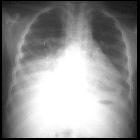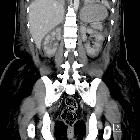Renal artery occlusion (acute)


Renal artery
occlusion (acute) • Renal infarction - Ganzer Fall bei Radiopaedia

Renal artery
occlusion (acute) • Acute renal artery occlusion - Ganzer Fall bei Radiopaedia

Renal artery
occlusion (acute) • Renal artery thrombosis - Ganzer Fall bei Radiopaedia

Renal artery
occlusion (acute) • Complete devascularisation of transplant kidney - Ganzer Fall bei Radiopaedia

Renal artery
occlusion (acute) • Renal artery thrombosis - Ganzer Fall bei Radiopaedia

Renal
infarction: imaging findings on MDCT and CEUS.. Axial thick multiplanar reconstruction image showing lack of enhancement in the right kidney and lack of contrast filling in the right renal artery.

Renal
infarction: imaging findings on MDCT and CEUS.. Coronal thick multi-planar reconstruction image showing the unenhanced part of the kidney and the renal artery thrombosis. Note the presence of a supernumerary right renal artery.

Renal
infarction: imaging findings on MDCT and CEUS.. Coronal thick multi-planar reconstruction image showing the thrombosed right renal artery with the infarcted part of the kidney along with the normally opacified supernumerary artery and the respective normally enhanced renal parenchyma.

Renal
infarction: imaging findings on MDCT and CEUS.. Curved multi-planar reconstruction image showing the right renal artery thrombosis.

Renal
infarction: imaging findings on MDCT and CEUS.. Colour Doppler image showing lack of blood flow signals in the upper half of the renal cortex.

Renal
infarction: imaging findings on MDCT and CEUS.. Immediately after the intravenous administration of 1.2 ml of microbubbles, the renal cortex appears uniformly anechoic.

Renal
infarction: imaging findings on MDCT and CEUS.. CEUS image 32 seconds after the administration of microbubbles showing the arrival of microbubbles in the lower half of the renal cortex. No enhancement is seen in the infarcted upper half of the kidney (arrowheads).

Renal
infarction: imaging findings on MDCT and CEUS.. CEUS image 45 seconds after the administration of microbubbles showing the lack of enhancement in the infarcted part of the renal cortex (arrowheads) along with the normal enhancement of the lower part of the kidney.
Renal artery occlusion can happen acutely due to in-situ thrombus, embolism, or dissection. Unless immediately treated, it can lead to renal infarction .
Epidemiology
The condition is more common in the elderly, however, it may be seen in a younger age group if they have risk factors (described below). 10% of the cases have bilateral involvement.
Clinical presentation
Acute pain in the ipsilateral flank, lower abdomen or back are the usual presenting symptoms.
Pathology
Risk factors
- thromboembolism (e.g. atrial fibrillation, myocardial infarction, atrial myxoma, plaque rupture, bacterial endocarditis, etc.)
- trauma
- aortic dissection
- iatrogenic (e.g. endovascular intervention such as EVAR)
- hypercoagulable disorders
- sickle cell disease
- cocaine abuse
- congenital vascular disorders
- fibromuscular dysplasia
- transplant sepsis
Radiographic features
Fluoroscopy - IVP
- after contrast administration there may be faint opacification (or nonopacification) of the affected kidney (with 'rim nephrogram' sign)
- the affected kidney may be normal or enlarged
CT
- acutely swollen and edematous kidney with perinephric stranding
- patchy enhancement or non-enhancing kidney +/- 'cortical rim sign'
- wedge-shaped focal infarcts if a segmental artery occlusion
Angiography (CT/conventional)
CT angiography shows the hypodense thrombus within the lumen, with possible attenuation of distal branches.
Treatment and prognosis
Acute renal artery occlusion is an emergency and requires immediate intervention. Treatment modalities include anticoagulation and thrombolysis/thrombectomy with renal artery stenting.
Siehe auch:
- Niereninfarkt
- Fibromuskuläre Dysplasie
- Sichelzellenanämie
- Aortendissektion
- renal cortical necrosis
- cortical rim sign
- spontane Dissektion der Nierenarterie
- akuter Verschluss Arteria renalis
- thromboembolism
und weiter:

 Assoziationen und Differentialdiagnosen zu akuter Verschluss Arteria renalis:
Assoziationen und Differentialdiagnosen zu akuter Verschluss Arteria renalis:



